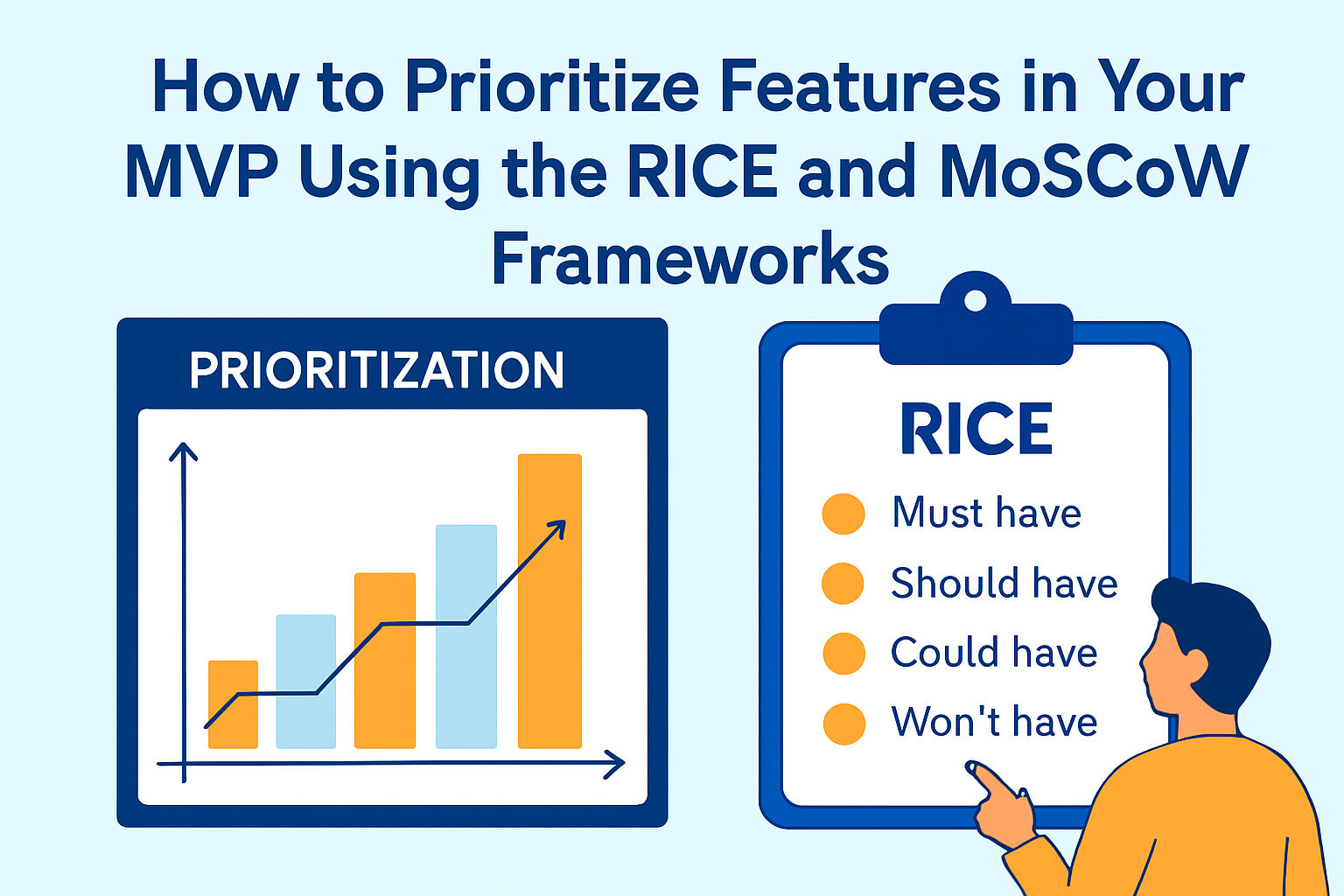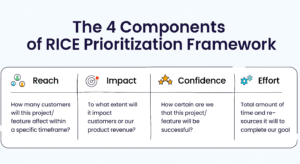
When building a Minimum Viable Product (MVP), one of the toughest challenges is deciding what to include and what to exclude. It’s a strategic balancing act that can determine the success or failure of your product’s first impression. What should be developed first? How do you ensure you’re investing in the features that truly matter to your users and stakeholders?
Feature prioritization is not just a step in MVP development – it’s the foundation of a smart, scalable, and user-driven product roadmap. Two tried-and-tested frameworks, RICE and MoSCoW, offer powerful and practical guidance to make these critical decisions.
Let’s explore what these frameworks are, how they work, and how to apply them to your MVP journey effectively.
What Makes Feature Prioritization Essential in MVP Development?
Feature prioritization isn’t simply about trimming features; it’s about sharpening focus. Early-stage products often suffer from either bloated scope or misaligned value propositions. A clear prioritization framework ensures that your MVP delivers real utility while avoiding costly detours.
For startups, scale-ups, and even enterprise innovation teams, this process ensures:
- Faster time to market
- Focused resource allocation
- Early user validation
- Reduced development waste
- Strategic clarity
This is especially critical in technology, healthcare, finance, and any domain where timing and relevance determine adoption.
What Is the RICE Framework?
The RICE framework helps teams rank features based on four factors:
- Reach – How many users will this impact over a set time?
- Impact – How much will it move the needle on your goals (e.g., activation, retention)?
- Confidence – How sure are you about your reach and impact estimates?
- Effort – How much time and resources will it take to build?
Each feature is given a score using this formula:
RICE Score = (Reach × Impact × Confidence) / Effort
This scoring method allows product teams to make more rational, data-backed decisions. Features that impact many users, create measurable outcomes, and require less effort rise to the top.

Real-World Application
In technology-driven MVP development (e.g., SaaS, B2B platforms), Product Siddha applies the RICE model during early roadmap planning to ensure limited developer time is spent on high-value, low-risk features. For example, when evaluating two onboarding features, the one with higher potential reach and user activation typically wins, especially when confidence is high and development time is low.
What Is the MoSCoW Method?
The MoSCoW method provides a qualitative prioritization technique by classifying features into four categories:
- Must-Have: Critical features without which the product fails its purpose.
- Should-Have: Important but not vital, can be added in future sprints.
- Could-Have: Desirable but not necessary. Adds polish or delight.
- Won’t-Have: Not needed now. Revisit later or drop altogether.
This method introduces a common language for stakeholders, product managers, and development teams to agree on what’s essential.
Where It Fits Best
MoSCoW works beautifully during MVP workshops and collaborative sprint planning. It helps teams avoid decision paralysis when debating low-impact or flashy features in sectors like healthcare, where compliance and reliability matter. Product Siddha uses MoSCoW to filter critical functionalities (like user consent, data access) from nice-to-have integrations.
When to Use RICE vs MoSCoW
While both frameworks are effective, they serve slightly different purposes:
| Situation | Recommended Framework |
| You have numerical data and estimates | RICE |
| You need stakeholder consensus quickly | MoSCoW |
| You want to rank features objectively | RICE |
| You’re facilitating a cross-functional workshop | MoSCoW |
| You’re building your product backlog | Both |
At Product Siddha, we often use MoSCoW to triage features early and RICE to finalize feature ranking once we’ve gathered estimates and data from engineering, marketing, and design teams.
How Product Siddha Applies These Frameworks in MVP Development
At Product Siddha, MVP development is a strategic collaboration between product consultants, design leads, and engineering teams. Here’s a simplified process we follow:
Step 1: Stakeholder Alignment
We begin with a joint workshop to understand the business goals, user personas, and constraints. This is where the MoSCoW method shines—helping identify Must-Have vs Could-Have features with speed and clarity.
Step 2: Effort and Impact Estimation
Using past data, engineering inputs, and user insights, we score features with the RICE formula. Features with higher RICE scores are flagged for inclusion.
Step 3: MVP Scope Lock
Once the initial list is refined, we validate it with users or internal stakeholders. The final MVP roadmap balances critical features with development bandwidth and market deadlines.
Step 4: Agile Execution and Review
We build incrementally in agile sprints, leaving room to promote Should-Haves and Could-Haves based on feedback and velocity.
This method ensures your MVP isn’t just fast—it’s focused, functional, and future-ready.
Advantages of Using RICE and MoSCoW for MVPs
1. Clarity in Decision-Making
Both frameworks reduce ambiguity. They give teams a repeatable structure to assess and prioritize what really matters.
2. Objective and Collaborative
RICE brings in data-driven logic. MoSCoW involves stakeholders meaningfully. Together, they bridge intuition and insight.
3. Efficiency
By weeding out distractions early, they reduce wasted cycles, unclear handovers, and rework.
4. Scalability
The same logic used to prioritize MVP features can be scaled for post-MVP iterations, launch sprints, and even long-term product roadmaps.
A Practical Contrast: RICE vs Gut Feeling
Consider this: You’re building a fintech MVP and debating whether to create a personalized dashboard or an API-based transaction sync.
Without RICE, teams might favor the dashboard because it “looks better.” But RICE might reveal:
- Transaction sync has a broader reach (more users affected).
- Higher impact on user retention.
- Moderate effort with high confidence from the dev team.
The result? A smarter MVP that solves real user problems first.
Conclusion: Prioritize Smart, Build Right
In today’s fast-paced digital environment, delivering an MVP is not enough. Delivering the right MVP, one that resonates, scales, and grows with users, is what separates successful products from wasted opportunities.
Using RICE and MoSCoW frameworks enables product teams to focus on what counts: user impact, business outcomes, and development efficiency.
At Product Siddha, we champion these frameworks as essential tools in our MVP development playbook. Whether you’re launching your first product or refining your tenth, how you prioritize will define what you build and what success looks like.
